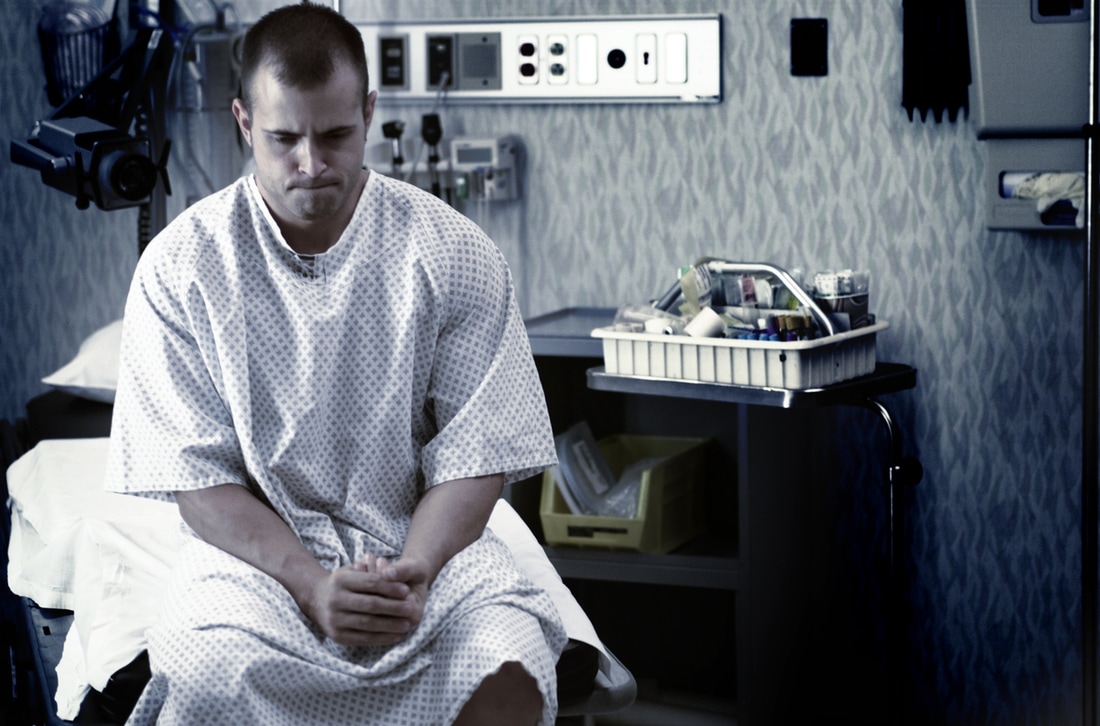Crossing The Finish Line
The end of cancer treatment -- when you've finished your chemotherapy, radiation, and/or surgery -- is a time of celebration. It usually marks the finish line after a marathon stretch of appointments, side effects, and coping with the disruption of your normal schedule.
But the end of treatment can also be a big letdown. The frequent visits are replaced by infrequent checkups. The busy schedule eases off. Patients have more time to think about whether the cancer is cured and about their side effects. There may be concerns about physical appearance, uncertainty about future health, or anger about the toll that cancer has taken on their lives. This part of the cancer journey, after treatment is finished, is called survivorship. Survivorship can be incredibly difficult, as patients may feel like they are no longer actively treating their cancer but just waiting with their fingers crossed. Having a road map for the future and an understanding of what’s to come, and what needs to be done, can help alleviate these concerns. Why a Road Map?
A road map not only gives patients an idea of what's to come, but can also help people from falling through the cracks. If a patient knows, for example, that for their type of cancer they need an appointment every 6 months with a special blood test and a CT scan, they can make sure that these get done. If one is missed, often a simple phone call is all that's needed to get back on track.
These visits and appointments are important for checking on the status of the cancer (hopefully gone!), and managing any lingering side effects. Each type of cancer has specific guidelines around the necessary follow-up procedures required. For some cancers, close follow-up and regular imaging are required, whereas for others, the follow-up is more spread out, imaging may not be necessary, and the follow-up might be done by someone other than your oncologist, like your family doctor. Proper follow-up is a balance: too few visits or investigations can lead to undetected problems, but too many can lead to wasted time and money, unnecessary anxiety, and, in the case of extra scans, unnecessary radiation exposure. A major effort is underway to keep patients from falling through the cracks after treatment by using survivorship care plans (SCPs). SCPs are recommended by the US Institute of Medicine and several other organizations. What is a Survivorship Care Plan?
An SCP has two parts. First is a treatment summary that includes the following information:
Second is the plan for ongoing follow-up. This includes:
Where Do I Get a Survivorship Care Plan?
There are two ways:
Several websites specifically offer free SCPs. These include Oncolife and Journey Forward. Both use a brief questionnaire to gather information from a patient or health care provider, then produce an SCP that can be reviewed with the health care team and used for future reference. SCPs Will be Trending in 2018!
Until recently, cancer programs hadn't been using SCPs consistently, even though they were recommended more than a decade ago. One study done in 2014 looked at 36 different cancer programs to see how many of those programs were successfully using SCPs. The study defined three benchmarks for success: creating SCPs for 75 percent of patients, delivering them to 75 percent of patients, and also delivering copies to 75 percent of family doctors or primary care providers. Of the 36 programs studied, only one met all three criteria.
But the numbers are going to skyrocket this year. Not only are patients becoming more aware of SCPs, but SCPs are now required for many institutions. The U.S. Commission on Cancer (CoC) is an organization aimed at improving outcomes for cancer patients by setting standards for cancer programs. There are approximately 1,500 CoC-accredited centers in the United States. The CoC requires that by the end of 2018, at least 50% of eligible patients are to receive SCPs at a given cancer treatment facility for it to be accredited. So the use of SCPs is going to increase rapidly. It’s worth getting an SCP. If you are not offered one, you can find one using the resources above, or you can ask your doctor to provide one for you.
Visiting a doctor can be like going to a foreign country where you don’t speak the language. Sometimes doctors use technical terms to communicate with each other about medical issues, just as pilots and mechanics each have their own languages. I’m sometimes confused when my mechanic is explaining what needs to be repaired on my car, so it’s natural for patients to get confused by the terms that doctors use.
Sometimes doctors skirt around sensitive issues, we use imprecise language to avoid upsetting patients, and we let medical jargon creep into our vocabulary. This only makes things harder for patients. The Goals of Treatment
For some patients with cancer, the goal of treatment is to cure the cancer. Curing the cancer means that it is gone and will never come back. The patient lives out her normal life expectancy, and the cancer will not end her life early.
Other cancers cannot be cured. If the goal of treatment is not for cure, but to slow down the growth of the cancer, improve quality of life, and/or extend survival, then we call the treatment "palliative". Learn more about the importance of knowing the goals. The Mission: Remission
So what does it mean when a cancer is in “remission”? Remission means that the cancer has gotten smaller, almost always because of a treatment that has helped. It doesn’t necessarily mean that the cancer has gone away completely. If some or all of the tumors are still visible but smaller, then it’s “partial remission.” If all the tumors have disappeared from the scans, then we use the words “complete remission,” meaning that there is no sign of any cancer.
After several years in complete remission, we often say a patient is “cured.” Why do we need to wait several years? Because our scans cannot detect small spots of cancer that are less than a few millimeters in size. If a patient is scanned immediately after treatment and there are no signs of cancer, we still need to wait to make sure that there are no microscopic spots that grow over time and become detectable a few years later. For some types of cancer, five years is enough time. For others, it is longer. Cancer-Free
What about being “cancer-free”? This can be a confusing term that is used loosely. We really only know that someone is “cancer-free” when several years have passed after treatment and she is considered cured. The situation becomes muddled because some people use the term “cancer-free” to mean “complete remission,” meaning that the scans do not show any spots of cancer after treatment. This is not truly “cancer-free,” because we can’t be sure that there are no cancer cells still lingering until the patient passes the test of time.
Ask Your Doctor
If you are a patient who has been treated for cancer, ask your doctor to clarify two things:
I met a patient recently, a lady I'll call Lisa, who was in her mid-50's and previously completely healthy. She had noticed a lump growing on the right side of her neck, about the size of a tangerine. A few days later, a lump developed on the left.
She was quickly referred to an ear, nose, and throat doctor, who also noticed a growth on her tonsil. A biopsy of the tonsil and one of the lymph nodes in the neck showed a type of cancer called squamous cell carcinoma. Special testing revealed that Lisa's cancer was caused by the human papillomavirus (HPV). HPV causes a few other types of cancer (including cervical cancer in women), but HPV-related throat cancer is becoming increasingly common. These types of throat cancers often develop between the ages of 50 and 75. Historically, the risk factors for throat cancers have been mainly alcohol and tobacco, so to find a throat cancer in a non-smoker and non-drinker used to be uncommon. That is no longer the case. The good news for Lisa is that HPV-related cancers are very curable. With a combination of chemotherapy and radiation (a common approach in Canada), or sometimes surgery with radiation afterward (a common approach in the US), cure rates approach 90% in patients like Lisa. In this business, a 90% cure rate is excellent. (Side note: we have just completed a trial comparing the US and Canadian approaches - results next year). But Lisa was very hesitant for any treatment. She shared that she'd seen a naturopath prior to visiting us, and the naturopath had told her that the cancer was incurable. She was told that standard treatments could 'hold the cancer' or cause it to shrink 60% of the time, but that eventually it would grow and cure was not possible. Lisa's husband, who also came to both appointments, confirmed what the naturopath had said. Having delivered that information, the naturopath then sold her some 'treatments' that really don't do anything against cancer, including high-dose vitamin C. Understandably, having been led to believe that her cancer was incurable, Lisa was hesitant to try the treatment recommended by our head-and-neck cancer team. Sometimes people think that alternative treatments are harmless, but there is the real potential for harm here. Lisa's cancer is curable now, but it might not be curable in a few months. If it spreads to other parts of her body, it will be incurable and would then end up taking her life. The naturopathic industry has become a Wild West of inaccurate medical claims. For some stories of what goes on behind the scenes, check out a website run by a former naturopath (Britt Marie Hermes) who was shocked by what she saw and is now trying to get the word out (www.naturopathicdiaries.com). These wild medical claims harm our patients: they provide false information, they sell expensive treatments that don't work, and in some cases (like a patient who is misled into abandoning curative treatments) can cost lives. We need oversight of naturopaths. As a stark contrast, let's consider what would happen to me, as an oncologist, if I told Lisa the same thing that her naturopath reportedly said:
And these would all be reasonable punishments for such a serious transgression. Why do we have a double standard, where a doctor would be seriously punished for actions that seem common in some naturopathic offices? After a long, honest discussion, Lisa has opted to undergo treatment. We won't know if she's cured for five years. But her chances are excellent. If she had listened to her naturopath, we might have lost our chance at a happy ending. Naturopaths are profiting by proving false medical information that harms our patients, but helps their own bottom line. No one is stepping in to stop them. We need our government and health regulators to step in and provide oversight in the Wild West of alternative treatments. To read more about naturopathic cancer treatments, see a guest post from Britt Marie Hermes: Naturopathic Cancer Care: Is it safe, and does it work? *Lisa's identity has been changed to protect her confidentiality
The following is an excerpt from Taking Charge of Cancer: Chapter 6 - Is Your Doctor’s Recommendation Best for You?
For many types of cancer, the best treatment approach is well-established. Sometimes surgery is the #1 choice. This is true for early-stage breast and colon cancers. Other times, it's radiation as the top choice. This is the case for some head and neck cancers. When the best approach is clear, there is very little debate.
But in some scenarios, the debate is intense. Let’s consider a patient with stage I lung cancer. Stage I means that the lung cancer is small - 5 cm (2 inches) or less - and hasn’t spread to any other parts of the body. These cancers are highly curable. The disagreement over how this patient should be treated illustrates some of the biases inherent to medicine. For more than 50 years, the standard treatment in this situation has been surgery, giving the best chance of cure. Radiation has been the second-choice treatment option, used mostly for patients who were too unwell to undergo surgery. But the tides are shifting. A new type of precise radiation treatment has been developed, stereotactic radiation. The results have been very good, generally with few side effects. Some doctors are now calling for stereotactic radiation to replace surgery as the treatment of choice. Ideally, we would now have randomized trials to compare these two options, but we don’t. A few were tried, but not enough patients joined to allow for any strong conclusions. [You can read the report from two of the trials here]. Since we don’t have randomized data, the truth is that we don’t know for sure which of the two treatment options is better, because we have incomplete evidence. If you took a poll of doctors, some might favor surgery, some might favor stereotactic radiation, and some might be undecided. The Problem The problem is that doctors’ beliefs are heavily dependent on what they do for a living. If you ask radiation doctors, 80 percent believe that surgery and radiation are equally effective in this situation. If you ask surgeons, the number is only 20 percent. And if you ask a neutral party (in this case, lung specialists who don’t do surgery or radiation), the number is almost exactly in the middle: 49 percent. [1] Clearly, doctors are being swayed more by their profession than by the scientific evidence. We see the same pattern in the treatment of men with early prostate cancer: the large majority of surgeons believe that surgery is better, but the large majority of radiation oncologists think that radiation and surgery are equally effective. [2] The same biases also arise when you ask doctors about side effects of treatment. Radiation oncologists predict worse quality of life after surgery than surgeons do, and surgeons predict worse quality of life after radiation than radiation oncologists do. [3] It appears that doctors have a rosy view of the treatments that they provide themselves and a less rosy view of treatments provided by other specialties. The Impact of Biases Because of these biases, the type of doctor that a patient meets can have a big impact on the type of treatment that he or she gets. For men with early prostate cancer, a big determinant of treatment choice is the type of doctor the patient is seeing, whether it’s a radiation doctor or a surgeon. [4] If you see a surgeon, you are more likely to have surgery, and if you see a radiation doctor, you are more likely to have radiation. The type of physician seen is even more strongly associated with the ultimate treatment choice than the patient’s own preferences about side effects! This suggests that physician bias is spilling over into treatment decisions. We should be providing patient-centered care, where treatment is based on the beliefs and preferences of individual patients, but this data suggests that we are not. [5] The bottom line is that specialists tend to favor whichever treatment they themselves provide. This bias, specialty bias, can be a major problem for patients. Patients rely on doctors to provide balanced information so that they can make an informed decision. If our opinion is skewed in favor of our own treatment—favoring our own specialty—can we really provide balanced information? Compounding the issue is that once the bias sets in, doctors may be less willing to do studies to test their own treatments, for fear that they may lose out. Tom Treasure, MD is a British thoracic surgeon who has dedicated much of his career to undertaking rigorous assessments of surgery, including randomized trials, and challenging conventional beliefs. In discussing the debate about the optimal treatment of early lung cancer (the comparison of surgery and stereotactic radiation we discussed above), he states that “in an era when evidence is expected for treatments, the fact that these interventions have still not been properly assessed is shameful.” [6] A big problem with these turf wars is that patients are caught in the middle, with no easy way to determine the best approach. “Trust me, I’m your doctor does not have the ring of truth,” continues Dr. Treasure, “when different doctors claim to know what is best while consistently failing to encourage trials to put their beliefs to the test.” Questions to Ask Your Team For a patient diagnosed with cancer today, there’s not time to wait for future trials to be completed. Here are some questions you can ask of your treatment team:
References
[1] Hopmans, W., et al. 2015. "Differences Between Pulmonologists, Thoracic Surgeons and Radiation Oncologists in Deciding on the Treatment of Stage I Non-Small Cell Lung Cancer: A Binary Choice Experiment.” Radiotherapy and Oncology 115(3): 361–66. [2] Fowler, F. J., Jr., et al. 2000. "Comparison of Recommendations by Urologists and Radiation Oncologists for Treatment of Clinically Localized Prostate Cancer.” Journal of the American Medical Association 283(24): 3217–22. [3] For data showing how doctors tend to overestimate side effects from other specialties’ treatments and underestimate side effects overall, see Kim, S. P., et al. 2014. "Specialty Bias in Treatment Recommendations and Quality of Life Among Radiation Oncologists and Urologists for Localized Prostate Cancer.” Prostate Cancer and Prostatic Diseases 17(2): 163–69. [4] See Sommers, B. D., et al. 2008. "Predictors of Patient Preferences and Treatment Choices for Localized Prostate Cancer.” Cancer 113(8): 2058–67; and Jang, T. L., et al. 2010. "Physician Visits Prior to Treatment for Clinically Localized Prostate Cancer.” Archives of Internal Medicine 170(5): 440-50. [5] For a commentary on this topic of physician-driven treatment choice, see Barry, M. J. 2010. "The Prostate Cancer Treatment Bazaar: Comment on ‘Physician Visits Prior to Treatment for Clinically Localized Prostate Cancer.’” Archives of Internal Medicine 170(5): 450–52. [6] In Treasure, T., R. C. Rintoul, and F. Macbeth. 2015. "SABR in Early Operable Lung Cancer: Time for Evidence.” Lancet Oncology 16(6): 597–98.
Insomnia is a common problem in cancer survivors. In women previously treated for breast cancer, for example, approximately one-third are diagnosed with insomnia. Sufferers of insomnia can have difficulty falling asleep, and they awaken often during the night, only to find themselves unable to get back to sleep. This can lead to tiredness, low energy levels, difficulty with concentration, and mood disturbances.
Insomnia is often treated with medications, but the best treatment has generally been considered to be cognitive behavioral therapy (CBT). CBT combines cognitive therapy (a type of psychotherapy where unhelpful thought patterns are challenged in order to change behavior) with better habits, including relaxation in the evening and avoiding stimuli. CBT is better than medications in treating insomnia, but CBT can be hard to access, due to cost and availability of psychotherapists. There is a new option that holds promise for treating insomnia, a form of Tai Chi called Tai Chi Chih (TCC). TCC combines slow, deliberate physical movements with relaxation and mediation, and is termed a 'movement meditation'. TCC has been shown to help with insomnia in older adults, and also improves depression and fatigue. In a new study published last week, researchers from UCLA compared CBT (the current 'best treatment' for insomnia) with TCC in a group of breast cancer survivors with insomnia. This was a randomized study, where women were assigned at random to one of two groups: one group received CBT, and the other received TCC. Randomized studies are important in medicine, because they allow for the most unbiased comparison between two treatment approaches. The UCLA researchers used a special study design where they wanted to show that TCC was not worse than CBT. If successful, it would mean that there are two 'gold standard' treatments for insomnia, CBT and TCC. The TCC approach used in the study was based on a TCC program described in the book T'ai Chi Chih! Joy Thru Movement by Justin Stone. It consisted of weekly sessions, two hours long, and lasted 3 months in total. Ninety women entered the study and were allocated to one of the two groups. In the CBT group, 44% showed an insomnia treatment response by 15 months. In the TCC group, the corresponding number was 47%. The two groups showed similar improvements in other measures, such as sleep quality. We can conclude that TCC is essentially just as good as CBT. Although this study looked only at breast cancer survivors, it's reasonable to assume that the benefits would be seen in survivors of other types of cancer, especially since TCC has been previously shown to be helpful in other settings. If you are a cancer survivor suffering from insomnia, TCC might be worth a try. |





 RSS Feed
RSS Feed